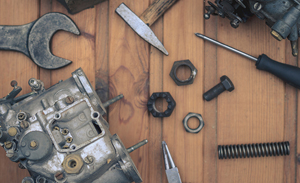Sometimes, the Right Tool is What You Have On Hand


|
| Who needs a bunch of “proper” tools when you have a clothespin? |
My first car was a 1984 Chevrolet Chevette. I could only describe the color as non-descript. It had a manual transmission and handled like a Go-Kart. The engine sounded a bit like the whir of a Fisher-Price lawnmower.
Shortly after getting this gem of a Chevy, I had a problem with its little four-cylinder randomly stalling and generally running rough. It turns out the carburetor wasn’t letting in enough air. The choke valve occasionally stuck closed, suffocating the combustion process. The car was gasping for air.
My solution was uniquely resourceful for a teen boy with a passing knowledge of how cars work. If the choke valve sticks, obviously I needed something to keep it open. A wooden clothespin did the trick. Of course, with the choke valve always propped open the car idled at 2,000 rpm. But I didn’t care. It didn’t stall out any more and I kept the feeling of freedom that only comes from being 16 and having your first car.
I was thinking about this episode recently after reading this month’s submission from columnist Howard “Porky” Cutter (page 45). He describes his son, Chris, fashioning a pump hoist mast from metal tubing traditionally used for fence material in Haiti. Chris “Piglet” Cutter developed his make-shift hoist to service hand-pump wells, bringing groundwater to people who badly need it.
Welding a mast for a pump hoist and jury-rigging a carburetor have nothing in common except perhaps a spark. That spark of innovation and creativity out of necessity is something I’ve come to appreciate about drillers. It’s taking a problem and solving it with the tools and talent on hand. When you’re young and can barely afford gas for your car, a three-cent clothespin looks like a viable and even clever way to fix a carburetor. When you’re working in Haiti — or on any other jobsite where the work is more plentiful than the tools to do it — you get creative. You look at the tools, equipment and resources you have, and you make it work.
That resourcefulness runs deep in the people who become drillers. Wayne Nash touches on it in this month’s column, too (page 44). He talks about manufacturers working hard to bring new tools to market only to have drillers shrug and say, “I built one of those years ago.”
I salute that spark of innovation. Long ago the skills needed to fix my own car slipped out of my fingers. Heck, cars don’t even have carburetors anymore. With modern advances and all the computer chips in my Toyota’s engine, I barely have reason to open the hood. Even if I did, I wouldn’t understand what went on inside. I’m resourceful in other ways (so if you ever need to properly split an infinitive, let me know).
But drilling, as a trade, requires plenty of creativity and resourcefulness these days. Drillers often need at least a basic, troubleshooting understanding of mechanical engineering, geology, fluid dynamics, hydraulics and chemistry. And sometimes, in order to get the job done, they need to pull a pump hoist out of thin air. Often, the right tool is what’s on hand.
How’s that for a “skilled” trade?
What do you think? Do you have a good story about innovation on the jobsite that’d make MacGyver proud? Tell me about it. Send an email to verduscoj@bnpmedia.com.
Stay safe out there, drillers.
Looking for a reprint of this article?
From high-res PDFs to custom plaques, order your copy today!









